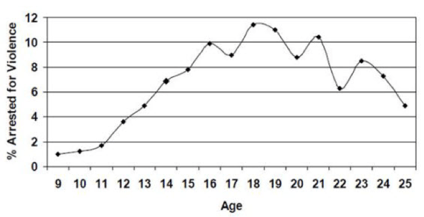Over the course of the last twenty or so years, there has been much discussion focused on the causes of juvenile crime. Studies have been conducted, people have been surveyed, facilities have been inspected, and it has all lead to at least one solid conclusion: there is no one condition that leads an adolescent to committing a crime. Instead, researchers have found that a myriad of risk factors increase a youth’s likelihood of offending. When an individual possesses several of these risk factors, they interact to multiply the chances of them getting involved in the justice system. The risk factors identified by years of research can all fall under the umbrella of a few generalized labels: individual characteristics, family characteristics, school influences, peer influences and neighborhood environments.
Understanding the Characteristics
Individual characteristics are typically considered demographic-type factors, including gender, race, and age. It also includes psychological factors as well, as mental health issues are a very prevalent issue among youth involved in the juvenile justice system. An estimated 50-75% of at-risk youth have at least one mental health disorder; of that percentage, two thirds have more than one mental health disorder. In the case of gender, we find that violent crimes are committed by males far more frequently than by females. A study conducted in D.C., for example, showed that 82% of violent crimes committed by youth in the district, including rape, aggravated assault, robbery, and homicide, were committed by males. A similar study in South Carolina found their rate of violent male offenses at 88%. In regard to age, studies by Rolf Loeber and Rebecca Stallings have shown an age-crime curve1 in which the arrest rate of teens for violent crimes peaks within a certain age range.

The curve peaks between the ages of about fifteen and twenty, and then declines through the early twenties. There are some variations to the curve when accounting for different factors. The violent crime curve peaks at a slightly later age than it does for property crime, and the curve for females peaks earlier than for males.
In addition to individual characteristics, environmental factors also play a part in the likelihood of juvenile offense. One of the biggest factors is the home life of youth. Teens with poor relationships with their parents, including abuse, neglect, inappropriate/ineffective punishment habits, and low supervision, have a higher chance of offending. This is also true when an adolescent is separated from their parents and placed in foster care. A relatively small study published in 2001 followed 250 ten- year- old males until they were the age of 45 to find predictors of crime involvement. The study found that the biggest predictors of criminal involvement were related to poor parental relationships. A further environmental factor affecting juvenile offense is the economic standing of a teen’s family. Youth raised in low-income families have a much higher rate of arrest than those from upper or middle-class families. Furthermore, the neighborhood in which an individual is raised also influences their likelihood of offending. Youth that are raised in neighborhoods with prevalent crime, drug, or gang issues are significantly more likely to offend. The report, Combating Racial Disparity in the Juvenile-Justice System with MST, shares that many studies reveal contributors to disproportionate minority contact, including selective enforcement, indirect effects of socioeconomic status, differential offending and administrative practices, institutional racism and biased risk-assessment instruments.
Tackling the Issue
When attempting to resolve the issue of reducing the number of troubled teens within the detention system, it is critical that we consider the circumstances that lead youth down a path of crime. It is only when we understand these circumstances and provide effective treatment to address these risk factors that we can help prevent or mitigate the effects they have upon the young and thus be able to prevent them from becoming further entangled in the juvenile justice system.
1Loeber, Rolf, and Rebecca Stallings, “Modeling the Impact of Interventions on Local Indicators of Offending, Victimization, and Incarceration,” in Young Homicide Offenders and Victims: Risk Factors, Prediction, and Prevention from Childhood, eds. Rolf Loeber and David P. Farrington, New York: Springer, 2011: 137-152.
Orbis Partners provides solutions for criminal justice and human services systems, specializing in designing and implementing services for at-risk client groups. Orbis offers a unique blend of programs and services including innovative case management software applications, evidence-based interventions, and effective risk assessment tools. For more information about assessment tools related to youth mental health, visit our Youth Mental Health Assessment page by clicking here.


